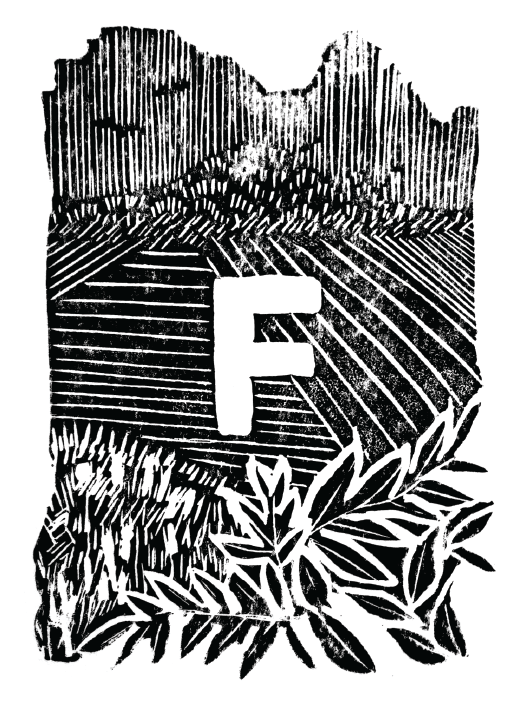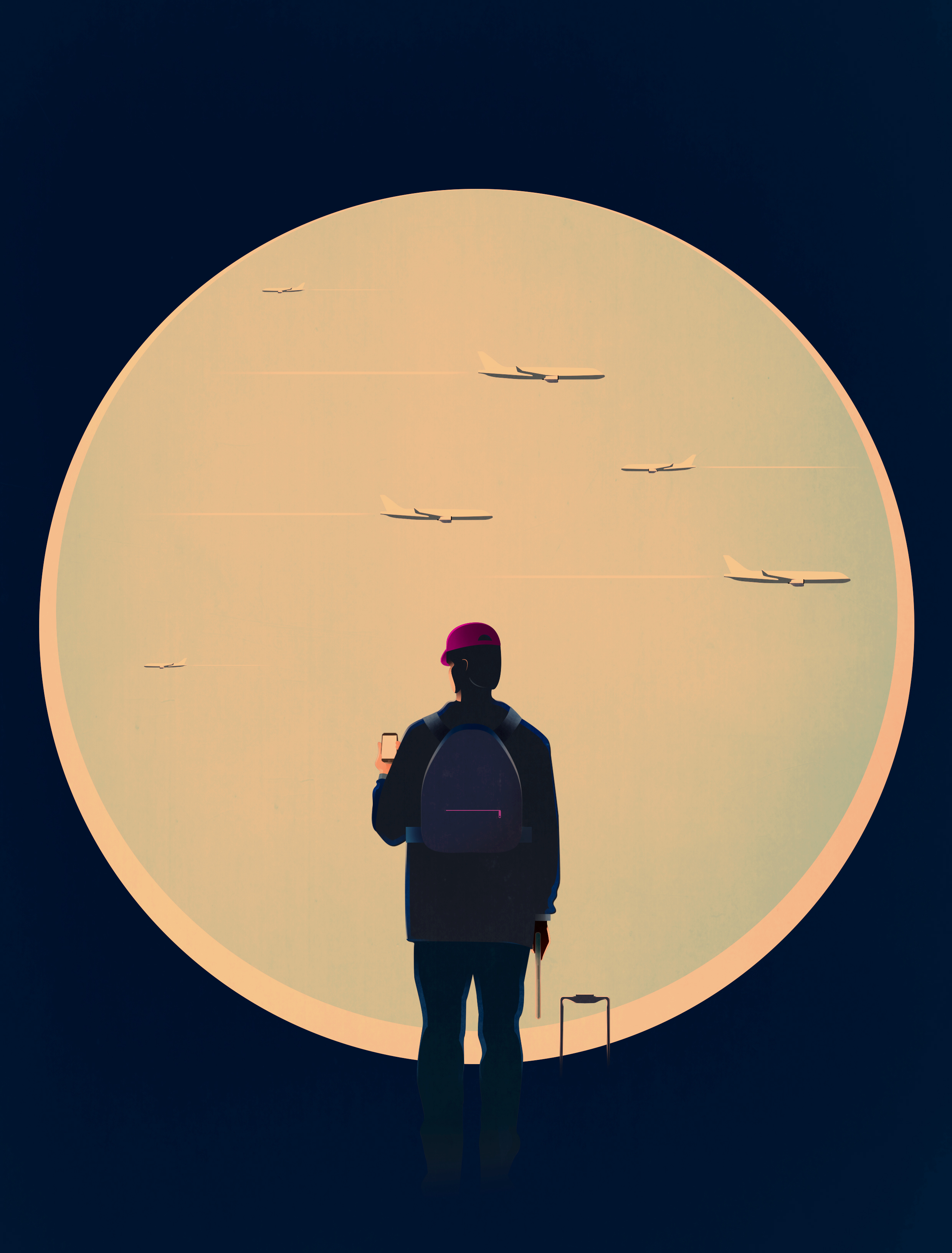Drawing on Photographs
Until eleven years ago, London had ‘always been home’ for Matt. Today, the self-taught digital illustrator works from a converted outbuilding within steps of his rural Dorset home. His provocative, sibylline style has attracted international clients including The Guardian, Financial Times, New York Times, XL Recordings, The Economist, and Creative Review. Here, he chats about his first segue into editorial illustration, the importance of natural light and city visits, and how every day must begin with a morning run.
Words below by Matt.
‘I’m an illustrator who happens to live in the countryside rather than a countryside illustrator. The internet gave us the power to move away from high rents and crowded trains.’
I have always been interested in art. None of my family knew about art or that you could make a living from it, so I grew up a little blind to the industry. In school, I worked hard in art and decided to do a foundation. I began to find out more, to discover more artists, but I moved into photography (not illustration) and completed a photography degree before becoming a photographer’s assistant.
When I first started illustrating, I scanned my photographs then altered and drew over them on a computer. It was very scruffy and dark. I got a lot of editorial commissions from this but I began to get frustrated by the limitations of this process and ended up drawing more and more of the illustration myself, leaving out the photographs over time. I have since tried to simplify what I do, to the most simple lines and graduations – less is more, as they say.
I grew up in Milton Keynes, before there was anything but concrete, cows, and a massive shopping centre. Home for me though has always been London. I studied in Watford and Reading, then moved to London after graduation. When my partner got offered a position in Somerset, I stayed behind in the city for six months. After a while, we realised we wanted to try living in the country (she is from Dorset, originally). We tried various places and looked at Bristol, but it didn’t feel quite right at the time. Maybe after moving from London it felt too similar. I liked the idea of a complete change of scenery. We spent a brief six months in Bath before moving to Dorset.
One of the main reasons we bought our house was the outbuilding. We’ve been doing the house up for nearly three years and it’s almost finished. The outbuilding is great and only two meters from the front door. Our terrace is a Dorset take on a London muse, so the outbuildings sit on the left and the house sits on the right, with the path through the middle. It’s the perfect situation as I can pop in and out and see my family throughout the day, but when I need to get my head down I am not disturbed. I need a really clean space to work in, to have music or cricket on, and to go running every morning. My head is constantly busy so the tidy workspace helps me concentrate.
What do I enjoy most about living and working in Dorset? The light and the countryside itself. I love my morning runs through woods and lanes as the sun is rising. I love my son's engagement with nature and especially the ocean – he gets to feel the sand and sea almost every weekend. And the pace is nice, it allows me to think in a more considered way. I hate living in dark places (too much time in the city maybe?). I think we might move closer to the coast eventually, I would love a studio by the sea. All the light, all day long, and a vast landscape. …Great places to eat are also very important!
‘The pace allows me to think in a more considered way.’
I suppose people are more engaged with the rural side of life these days, there seems to be a newfound love of our countryside and living a simple life in it. But, I feel that I am an illustrator who happens to live in the countryside rather than a countryside illustrator. The internet gave us the power to move away from high rents and crowded trains.
And, work-wise, the move didn’t affect anything. I sent MailChimp regularly and still visited London once a month to show my folio. These days, I have my agents, Handsome Frank, and they take care of the business side of things so I am free to concentrate on the creative side of things more.
What do I find most challenging about living and working here? People walking really slowly and then stopping suddenly in the street! In London, no one does this! Feeling left out of a creative network can be tough sometimes, but where we live it’s getting better, and Bridport down the road is great for this. I miss the small galleries in London, so having creative inspiration can be tough occasionally.
I find twitter to be a good source of staying connected, and chatting to fellow illustrators. Also making the effort to visit cities regularly, not just London but Bristol, Manchester, Berlin, etc, really gives you the buzz. And the best part is you then get to go back to the serene countryside.
‘I hope conceptuality continues to grow within the industry so we have more content over style.’
It’s never easy to predict future trends within a creative industry. I think it will continue in this clean modern style for a while yet, and I hope conceptuality continues to grow within the industry so we have more content over style. The editorial illustration scene is really strong at the moment, with far more emphasis on conceptuality. However, I feel there is a danger that Art Directors are asking illustrators to mimic popular styles more and more, and illustrators coming through from graduating are not developing their own style. As long as illustrators fight back and keep creating strong styles I think it will be fine. And, of course, always charge for work, never work for free!
I have been doing this for sometime now and the one thing that has never changed is the process: I get briefed by the client or sometimes by my agent, I print out the brief and read it five to ten times to fully absorb it and to know it without reading it, then I begin work on sketches in my sketchbook. I might do two pages, I might do twenty, depending on the job, but I only stop once I have three concepts that I love. Once I have the three, I share them with the client who will hopefully pick one, then I work this up to a black and white rough, followed by a colour rough, and then final sharing with the client at various points along the way.
I love the freedom digital media gives. (Apple Z! Ha.) In seriousness – the colours, the brushes, the speed – it enhances my creative process, as long as I combine it with traditional practices. Almost all of my work is born out of commissions these days, so the subject matter is not from my own mind but from someone else's writing. But when I look at the work, it feels like there is a connection between them, like stills from the same film. I try to use angles and perspectives to draw the viewer in, to make them imagine what has happened before and what will happen after the scene they are viewing.
Currently, I might be working on my favourite project to date, but I can’t talk about it apart from that it’s beautiful, minimalist Japanese landscapes. I’ve had so many great jobs, I’ve been really fortunate. New York Times Magazine cover was a dream job. I’ve just completed a great packaging job for Johnnie Walker, and the 2017 Adele US tour poster job for XL Recordings was amazing. But I hate looking back and I’m always looking to improve on the next job. As Duke Ellington said, what I do tomorrow will be the best thing I’ve ever done.
Favourite tool of the trade: Sketchbook and pen, it’s how ideas are born. Currently I am using a Midori sketchbook from Japan and a Kaweco fountain pen from Germany.
Favourite way to start the day: Breakfast with my son and then a run.
I hope nuclear fusion energy and a vote on the Brexit deal become a reality in my lifetime.
Published on: March 2019. Edited by Fields in Fields. All images courtesy of Matt Murphy; cover image for Delve Media, content images for The Guardian, Forbes Japan, Aeon, The Guardian Guide, EasyJet, The Economist, The New York Times, Creative Review, GQ. ▪ Visit Handsome Frank and mattmurphyillustration.com.











